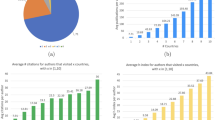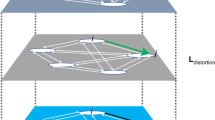Abstract
Patterns of migration among disciplines and specialties are examined using data from a large survey of U. S. Ph. D. s in a broad range of fields. Mappings of scholarly fields are derived from the migration patterns and these mappings are largely consistent with results from previous studies using citation flows and other measures of field similarities. Migration patterns suggest that there are two boundaries dividing the fields in this analysis, and that hierarchical relations among disciplines are weak or absent. In contrast, specialties within a discipline are more likely to exhibit structural hierarchies.
Similar content being viewed by others
Notes and references
D. DE SOLLA PRICE,Little Science, Big Science, New York, Columbia Univ. Press, 1965, pp. 62–91; W. O. HAGSTROM,The Scientific Community, New York, Basic Books, 1965, pp. 159–243; N. W. STORER, Relations among scientific disciplines, In: S. Z. NAGI, R. G. CORWIN (Eds),The Social Contexts of Research, New York, Wiley, 1972.
A. COMTE,The Positive Philosophy, trans. byHarriet Martineau, New York, Calvin Blanchard, 1858, pp. 437–438; E. DURKHEIM,The Division of Labor in Society, trans. byG. Simpson, New York, Free Press, 1947, pp. 356–357.
T. S. KUHN, Mathematical versus experimental traditions in the development of physical science, In: T. S. KUHN,The Essential Tension, Chicago, Univ. of Chicago Press, 1977 p. 34.
A. BIGLAN, The characteristics of subject matter in different academic areas,Journal of Applied Psychology, 57 (1973) 195; H. G. SMALL, Cocitation in the scientific literature: A new measure of the relationship between two documents,Journal of the American Society for Information Science, 24 (1973) 265; F. NARIN,Evaluative Bibliometrics: The Use of Publication and Citation Analysis in the Evaluation of Scientific Activity, Final Report on NSF Contract C-627, Cherry Hill, N. J., Computer Horizons, Inc., 1976.
ARISTOTLE,Posterior Analytics, trans. byJ. Barnes, London, Oxford Univ. Press, 1975.
W. O. HAGSTROM,op. cit., note 1, pp. 167–175. This structural definition of hierarchy is to be contrasted with non-network treatments of hierarchy as simply a rank ordering of fields on some dimension. For a discussion of this distinction, see R. L. BRIEGER, Career attributes and network structure: A biomedical research specialty,American Sociological Review, 41 (1976) 117. An example of the non-network approach to the concept of hierarchy is S. COLE, The hierarchy of the sciences,American Journal of Sociology, 89 (1983) 111.
H. G. SMALL, B. C. GRIFFITH, The structure of scientific literatures I: Identifying and graphing specialties,Science Studies (1974) 17; B. C. Griffith, H. G. Small, J. A. Stonehill, S. DEY, The structure of scientific literatures II: Toward a macro- and microstrucutre of science,Science Studies, (1974) 339; F. NARIN, op. cit., note 4.Evaluative Bibliometrics: The Use of Publication and Citation Analysis in the Evaluation of Scientific Activity, Final Report on NSF Contract C-627, Cherry Hill, N. J., Computer Horizons, Inc., 1976.
Small et al. have announced that they are currently experimenting with the combinedSCI/SSCI files in order to produce a more inclusive map of scientific disciplines. In addition to the very large data files involved, such analyses face difficulties which stem from the fact that citation practices vary significantly between the two groups of fields (see B. C. GRIFFITH, H. G. SMALL, The structure of the social and behavioral sciences literature,Proceedings of the First International Conference on Social Studies of Science, Ithaca, New York, Cornell University, 1976).Small andSweeney, andSmall et al. discuss methods that may be able to surmount these difficulties. See H. G. SMALL, E. SWEENEY, Clustering the Science Citation Index using co-citations I: A comparison of methods,Scientometrics, forthcoming; H. G. SMALL, E. SWEENEY, E. GREENLEE, Clustering the Science Citation Index using co-citations II: Mapping science,Scientometrics, forthcoming.
Cocitation techniques, for example, are designed to detect areas of high activity at a given time and to study how they change through time. These areas tend to be fairly small fields of research rather than institutionalized disciplines or specialties. H. G. SMALL, B. C. GRIFFITH; B. C. GRIFFITH, et al., op. cit., note 7. The structure of scientific literatures I: Identifying and graphing specialties,Science Studies, (1974).
W. O. HAGSTROM,op. cit., note 1,, pp. 69–104.
Van Houten et al. show that scholars trained in physics but currently working in other fields tend to work on their own research programs and to focus on basic rather than applied questions in those fields. Furthermore, they report that the physicists are more likely to be doing research than non migrant scholars in those fields. J. VAN HOUTEN, H. G. VAN VUREN, C. LE PAIR, G. DIJKHUIS, Migration of physicists to other academic disciplines: Situation in the Netherlands,Scientometrics, 5 (1983) 257.
Gieryn notes that using terms such as “movement”, “mobility”, or “migration” are misleading insofar as they imply a disjunctive transfer of a scholar's entire commitment from one field to another. He shows that a more frequent pattern is the addition of new lines of work to an existing research repertoire. This paper reports changes of scholars'primary research commitments and describes them as patterns of “migration” because there seems to be no satisfactory term that encompassesGieryn's objection. T. F. GIERYN, Problem retention and problem change in science, In: J. GASTON (Ed.),The Sociology of Science: Problems, Approaches and Research, San Francisco, Jossey Bass, 1978.
J. BEN-DAVID, Roles and innovations in medicine, American Journal of Sociology, 65 (1960) 557; J. BEN-DAVID, R. COLLINS, Social factors in the origins of a new science: The case of psychology, American Sociological Review, 31 (1966) 451; D. O. EDGE, M. MULKAY,Astronomy Transformed: The Emergence of Radio Astronomy in Europe, New York, Wiley, 1976.
D. URBAN, Mobility and the growth of science,Social Studies of Science, 12 (1982) 409.Urban bases his argument on results from a questionnaire that asked respondents to report the primary reason they changed university affiliations between 1974 and 1976. Nevertheless,Urban seems to exaggerate the extent to which job opportunities areindependent of cognitive changes within science; cognitive migration may be due to intellectual developments within science even though individual migrants attribute their movements to job opportunities. It should also be noted that a substantial proportion ofUrban's respondents, 35 percent, were graduate students.
E. NOMA, An improved method for analyzing square scientometric transaction matrices,Scientometrics, 4 (1982) 297.
Office of Scientific and Engineering Personnel, National Research Council,Science, Engineering and Humanities Doctorates in the United States: 1981 Profile, Washington, D. C., National Academy of Sciences, 1982, pp. 101–112.
These settings include business and industry, junior colleges, elementary and secondary schools, clinics and hospitals not part of medical schools, the military, and positions with local governments. See the complete list of organizational settings in Office of Scientific and Engineering Personnel,op. cit., note 17,.
See Office of Scientific and Engineering Personnel,op. cit., note 17,, pp. 68–72 for a reproduction of the survey questionnaire and specialty list. Most of these “specialties” correspond to what are normally called disciplines, such as genetics, anatomy, sociology and philosophy. In some cases, however, large disciplines are broken down into major subfields. For example, within chemistry analytical, inorganic, physical, etc. are distinguished. Below I focus on interdisciplinary migration patterns first and then briefly examine migration within each of the four large disciplines for which data on intradisciplinary migration are available.
For an overview of the general types, see R. S. BURT, Models of network structure,Annual Reviews of Sociology, 6 (1980) 79.
P. M. BLAU, O. D. DUNCAN,The American Occupational Structure, New York, Wiley, 1967.
L. A. GOODMAN, On the statistical analysis of mobility tables,American Journal of Sociology, 70 (1965) 564.
I used most of the general categories from the OSEP list for my analysis with a few exceptions. First, I split the “physics and astronomy” category into astronomy and astrophysics on the one hand and the remaining physics specialties on the other. Similarly, I broke the “earth, environmental and marine sciences” category into atmospheric sciences and geological sciences, with the latter including oceanography and other marine sciences. Following a distinction made byHagstrom, I separated the OSEP's general “biological sciences” category into two subcategories: experimental biology and other biology. The former includes such fields as biochemistry, molecular biology and physiology, and the latter such fields as botany, ecology and zoology. W. O. HAGSTROM, Competition in science,American Sociological Review, 39 (1974) 1. The OSEP also included “biomathematics”, “biostatistics” and “biometrics” in the biological sciences category, but since these fields seem distinct from the others in the category, I retained them as a separate group of fields, labeled biostatistics, for my analysis. The OSEP's “chemistry” category contained biochemistry as a specialty, but I combined it with the biochemistry category within the experimental biology category discussed above. I also combined the “humanities” and “languages and literature” categories from OSEP's list into a broader arts and humanities category for my analysis. However, I combined four history subcategories from the humanities category into a general history category. Finally, I excluded a number of professional fields from my study. These include such fields as law, social work, education, journalism, business administration, nursing and hospital administration.
For a summary of this last of work see J. C. SMART, C. F. ELTON, Validation of the Biglan model,Research in Higher Education, 17 (1982) 213. In addition to the work using citation flows and field similarities, there has been a little work on the “migration” of U. S. college students among fields. See J. L. SPAETH, Patterns of change in the long-run career fields of June, 1961 college graduates,Proceedings of the Social Statistics Section of the American Statistical Association, 8 (1965), 81.Spaeth's results are for highly aggregated groups of fields, but parallel those of this study in showing that the natural sciences are ordered from the physical sciences to medicine, and that there is little migration between (1) the natural sciences and (2) the behavioral sciences, arts and humanities.
B. C. GRIFFITH et al., op. cit., note 7. The structure of scientific literatures I: Identifying and graphing specialties,Science Studies, (1974).
F. NARIN, M. CARPENTER, N. C. BERLT, Interrelations of scientific journals,Journal of the American Society for Information Science, 23 (1972) 323.
J. C. SMART, C. F. ELTON,op. cit., note 26..
A. BIGLAN,op. cit., note 4..
Small's results are reported in E. GARFIELD,Citation Indexing: Its Theory and Application in Science, Technology and the Humanities, New York, Wiley, 1979, pp. 137–140.
A. BIGLAN,op. cit., note 4.. J. C. SMART, C. F. ELTON, op. cit., note 26. Validation of the Biglan model,Research in Higher Education, 17 (1982) 213.
F. NARIN,op. cit., note 4..
E. GARFIELD,op. cit., note 33,, pp. 111–118.
G. PINSKI, Influence and interrelationship of chemical journals,Journal of Chemical Information and Computer Science, 17 (1977) 67.
The indistinct boundaries between mathematical specialties is also reflected by the many intermediate subcategories in the subject classifications used byMathematical Reviews. See, for example, the Subject Index inMathematical Reviews: 1984 Annual Index, S1–S40.
See also G. A. KIMBLE, Psychology's two cultures,American Psychologist, 39 (1984) 833.
Physics Survey Committee, National Research Council,Physics in Perspective, Vol. 1, Washington, D. C.: National Academy of Sciences, 1972.
See H. G. SMALL, A co-citation model of a scientific specialty: A longitudinal study of collagen research,Social Studies of Science, 7 (1977) 139.
W. O. HAGSTROM,op. cit., note 1,, pp. 168–170.
Author information
Authors and Affiliations
Rights and permissions
About this article
Cite this article
Hargens, L.L. Migration patterns of U. S. Ph. D. s among disciplines and specialties. Scientometrics 9, 145–164 (1986). https://doi.org/10.1007/BF02017238
Received:
Issue Date:
DOI: https://doi.org/10.1007/BF02017238




